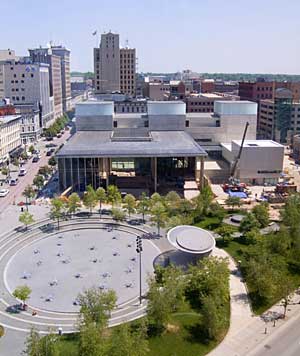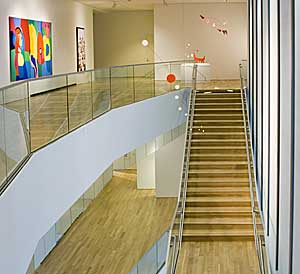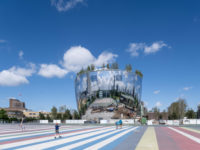The Grand Rapids Art Museum (GRAM) officially opens its new building to the public today. Although it is the Michigan institution’s third home in its 83-year history, the wHY Architecture-designed building is the first intended specifically as an art museum.


Photos: Courtesy Grand Rapids Art Museum
GRAM is best known for its collection of 19th and 20th century American and European paintings and sculpture. Its first home, in 1924, was in a converted mansion; it next occupied a converted Beaux Arts-Classical post office. Built at a cost of $75 million, the new 125,000-square-foot building sits on a slope overlooking a Maya Lin-designed park in the heart downtown. GRAM, pressed for space in its previous quarters, sought a modern design that would evoke its forward-looking mission.
“We wanted the grandeur and the magnificence of a museum building, but modern architecture has an open feeling,” explains museum director Celeste Adams. “The phrase used in the commission was ‘a building of our time.’ We wanted it to have a classic character but we wanted a modern design.”
The design process began in 2001 with an early concept prepared by Munkenbeck & Marshall, of London and New York City. GRAM then selected Kulapat Yantrasast and his team at wHY Architecture in Los Angeles to prepare the final design, working with architect of record Design Plus, of Grand Rapids. The team crafted a building that features a concrete-and-glass exterior with a large loggia at the entry; 38-foot-high ceilings in its central public space; and an openness in it its galleries and circulation spaces intended to allow natural light to play a major role.
Aiming for LEED Gold or Platinum or Gold certification, Yantrasast covered much of the building’s exterior with louvers, some fixed and others moveable, that regulate the amount of daylight. A reflecting pool, which uses recycled rainwater, separates a wing of museum offices from the building’s main public spaces.
The large amount of public space inside the new museum includes two sets of grand stairs, one to the left of the central hall and the other along the rear glass walls, providing distinctive diagonals in the otherwise symmetrical spaces. Yantrasast used white oak for gallery floors and the main welcome desk as an accent and a contrast with the mostly neutral color scheme.
Adams is delighted with the result. “We wanted a building that would attract great works of art as gifts, that would demand great works of art as acquisitions, and I think that’s what we have,” she says. Critical reaction in the local press has also been strongly supportive—and today it’s finally time for the public to judge for itself.





Post a comment to this article
Report Abusive Comment